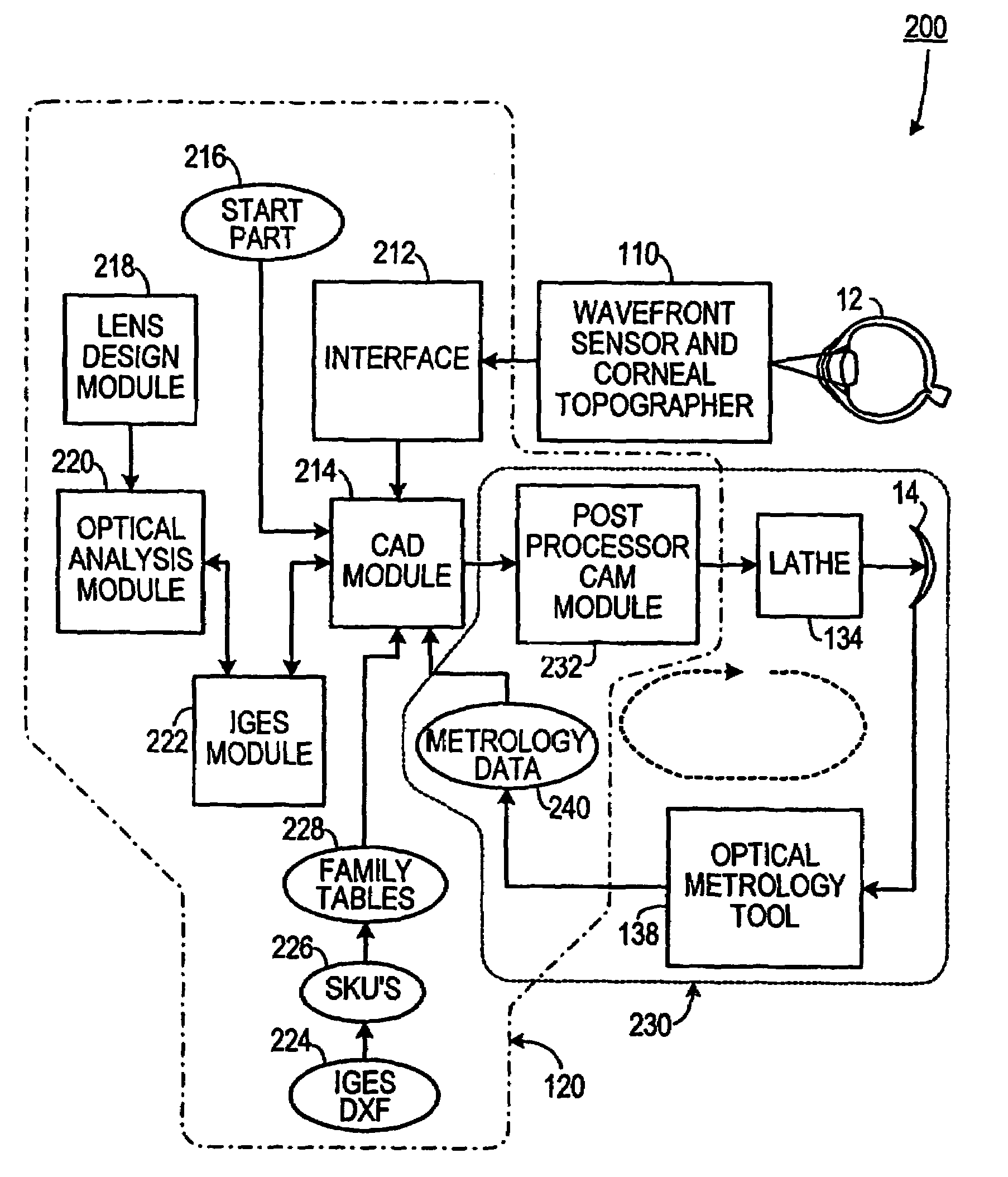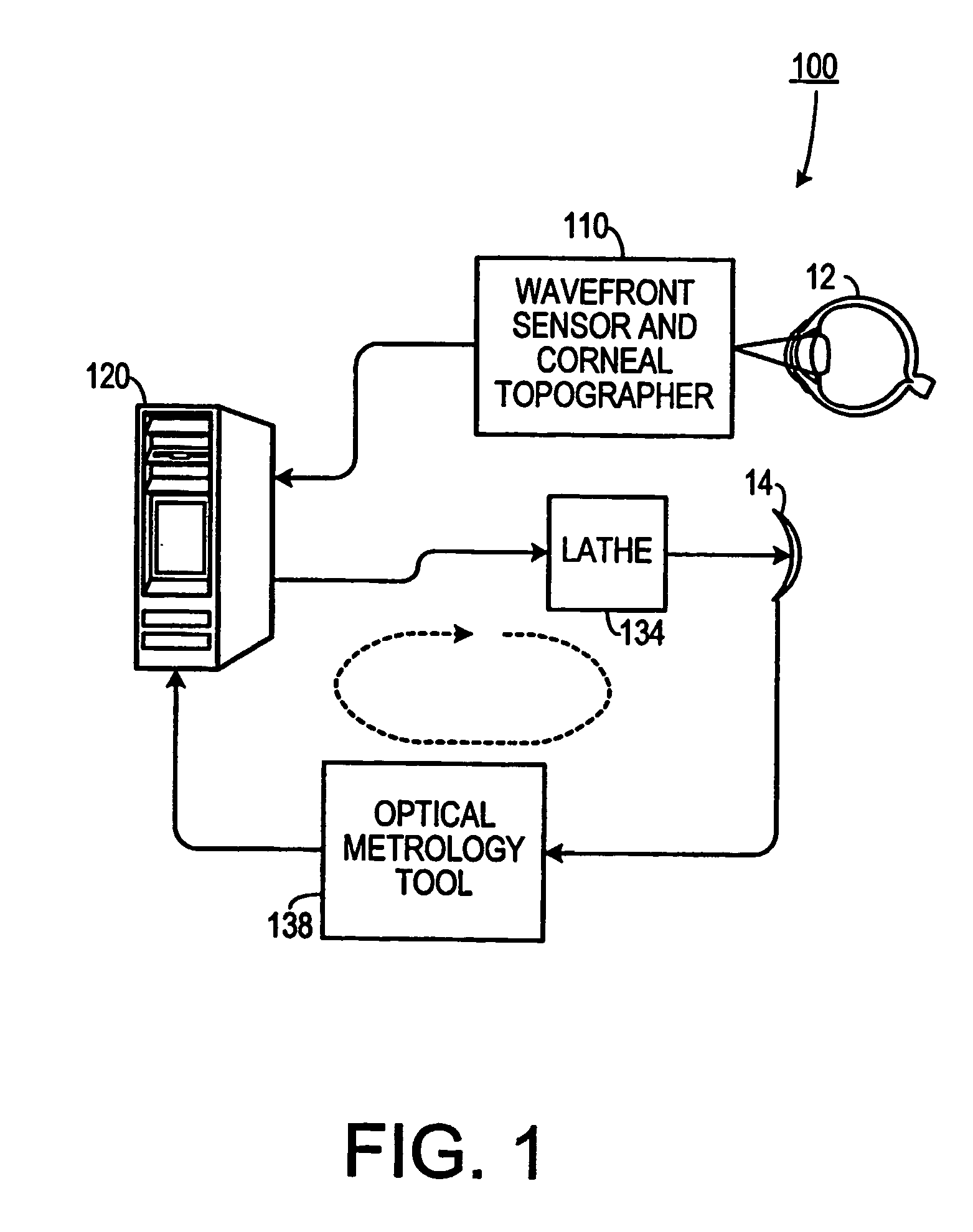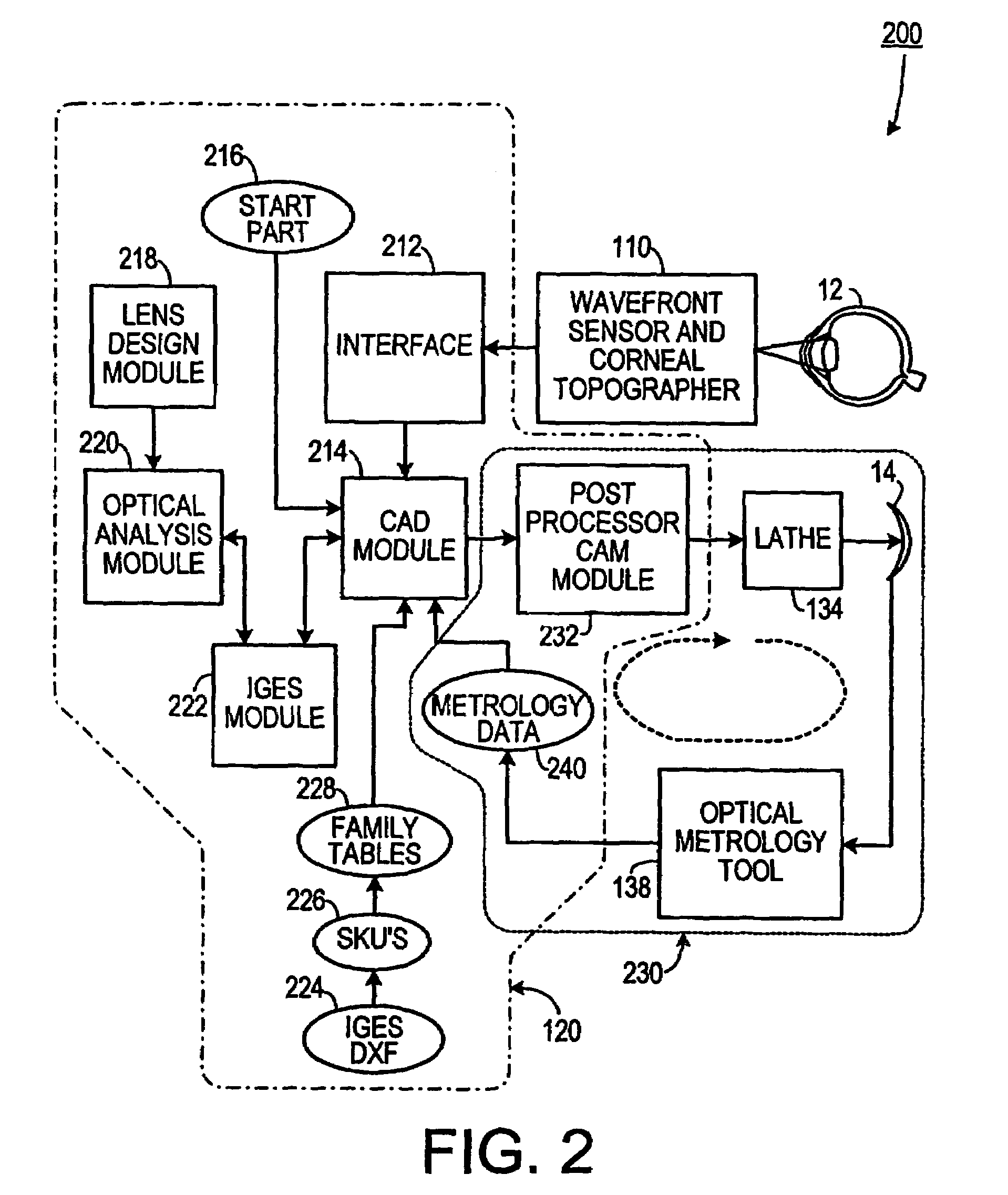[0015]The invention, in one aspect, provides a method for creating a computational model eye which reproduces aberrations of an eye of an individual and can find particular use in the design and production of a customized ophthalmic lens or an ophthalmic lens capable of correcting high-order aberrations. The computational model eye comprises: at least one refractive optical element having a first surface with a topography identical to the corneal topography and a second surface and a model retina having a model fovea having a lattice of pixels. The aberrations of an eye are reproduced by the optical element alone or in combination with at least one additional optical element. The method for creating a computational model eye comprises the steps of: (1) providing a set of characteristic data of an eye of an individual, wherein said set of characteristic data comprise wavefront aberrations of the eye and corneal topography data; (2) converting the corneal topography data into a mathematical description representing a first surface of a first refractive optical element, the first optical refractive element having the first surface and an opposite second surface; (3) designing and optimizing the second surface of the first refractive optical element so that the first refractive optical element, alone or in combination with a second refractive optical element that has a third surface and an opposite fourth surface and an index of refraction distribution, reproduces the wavefront aberrations of the eye; (4) designing a model retina that has a curvature of the human retina and comprises a model fovea having a lattice of pixels representing photoreceptors; and (5) arranging the first refractive optical element and the model retina along an optical axis in a way such that the distance between the fovea and the center of the first surface of the first refractive optical element is equal to the visual axial length of the human eye. Preferably, the computational model eye comprises a model crystalline lens as the second refractive optical element and a model cornea as the first refractive optical element, wherein the model crystalline lens is constructed on the basis of the crystalline lens of the human eye. In this preferred embodiment, the model cornea, the model crystalline lens and the model retina are arranged in a way identical to their corresponding elements in the human eye. More preferably, the computational model eye further comprises a pupil with a pupil size ranging from 2.0–8.0 mm, adjustable according to the individual's age and / or illumination light intensity.
[0016]The invention, in another aspect, provides an iterative process for optimizing an optical design of an ophthalmic lens. The iterative process comprising the steps of: (1) determining visual performance information of the optical design of an ophthalmic lens with a computational model eye that reproduces aberrations of an eye of an individual, wherein the computational model eye comprises a lens-supporting surface having corneal topography of the eye and a model retinal having a curvature of the human retina and a model fovea comprising a lattice of pixels that represent photoreceptors, wherein the distance between the model fovea and the center of the lens-supporting surface is equal to visual axial length of the human eye; (2) modifying the optical design of the ophthalmic lens on the basis of the visual performance information determined in step (1); and (3) repeating steps (1) and (2) until visual performance of a modified optical design of the ophthalmic lens is optimized.
[0017]The invention, in another aspect, provides a method and system for designing a customized ophthalmic lens or an ophthalmic lens which is capable of correcting high order aberrations. The lens-designing method comprises the steps of: (1) providing a set of characteristic data of an eye of an individual, wherein said set of characteristic data comprises wavefront aberrations of the eye and corneal topography; (2) creating a computational model eye that reproduces the wavefront aberrations of the eye, wherein the computational model eye comprise a lens-supporting surface having the corneal topography of the eye and a model retinal having a model fovea comprising a lattice of pixels that represent photoreceptors, wherein the distance between the model fovea and the center of the lens-supporting surface is equal to visual axial length of the human eye; (3) designing an optical model lens which is capable of compensating for the wavefront aberrations of the eye; (4) evaluating the visual performance of said optical model lens with the computational model eye; (5) obtaining visual performance information of said optical model lens; (6) modifying the design of said optical model lens on the basis of said visual performance information to improve corrections of the aberrations of the eye if the visual performance of said optical model lens is not optimal; (7) repeating steps (4) to (6) until the visual performance of said optical model lens is optimal; and (8) transforming the optimized optical model lens into a set of mechanical parameters for making said customized ophthalmic lens or said ophthalmic lens capable of correcting high order aberrations. The lens-designing system includes a computer system comprising: (a) a model eye design module for creating a computational model eye that reproduces aberrations of an eye of an individual, wherein the computational model eye comprises a lens-supporting surface having corneal topography of the eye and a model retina having a curvature of the human retina and a model fovea comprising a lattice of pixels that represent photoreceptors, wherein the distance between the model fovea and the center of the lens-supporting surface is equal to visual axial length of the human eye; (b) an optical design module for designing an optical model lens to compensate for the wavefront aberrations of the eye and to accommodate the corneal topography of the eye of the individual or an averaged corneal topography derived from population studies, (c) a lens-designing optimization module for performing an iterative optimization process comprising (1) determining visual performance information of the optical model lens with the computational model eye, (2) modifying the design of the optical model lens on the basis of said visual performance information to improve corrections of the aberrations of the eye if the visual performance of said optical model lens is not optimal, and repeating steps (1) and (2), if necessary, until visual performance of a modified design of the optical model lens is optimized; and (d) a mechanical design module for generating a CAD output file containing parameters for making said customized ophthalmic lens or said ophthalmic lens capable of correcting high order aberrations, based on the optimized optical model lens. Preferably, the system further comprises a sensor system, which is capable of determining the set of characteristics data of the eye.
[0018]The invention, in still another aspect, provides a method and system for producing a customized ophthalmic lens or an ophthalmic lens which is capable of correcting high order aberrations. The lens-producing method comprises the eight steps of the above lens-designing method and further comprises the following steps: (9) converting the set of mechanical parameters for making the lens into control signals that control a computer-controllable manufacturing device and (10) producing the lens using the computer controllable manufacturing device. The lens-producing system includes a computer-controllable manufacturing device and a computer system comprising: (a) a model eye design module for creating a computational model eye a model eye design module for creating a computational model eye that reproduces aberrations of an eye of an individual, wherein the computational model eye comprises a lens-supporting surface having a corneal topography of the eye and a model retina having a curvature of the human retina and a model fovea comprising a lattice of pixels that represent photoreceptors, wherein the distance between the model fovea and the center of the lens-supporting surface is equal to a visual axial length of the human eye; (b) an optical design module for designing an optical model lens to compensate for the wavefront aberrations of the eye of the individual and to accommodate the corneal topography of the eye of the individual, (c) a lens-designing optimization module for performing an iterative optimization process comprising (1) determining visual performance information of the optical model lens with the computational model eye, (2) modifying the design of the optical model lens on the basis of said visual performance information to improve corrections of the aberrations of the eye if the visual performance of said optical model lens is not optimal, and repeating steps (1) and (2), if necessary, until visual performance of a modified design of the optical model lens is optimized; (d) a mechanical design module for generating a CAD output file containing parameters for making the ophthalmic lens, based on the optimized optical model lens; (e) a signal module for converting said CAD output file into control signals that control the computer-controllable manufacturing device to produce said ophthalmic lens; and (f) a manufacturing control module for controlling the computer-controllable manufacturing device to produce said ophthalmic lens. Preferably, the system further comprises a sensor system, which is capable of determining the set of characteristic data of the eye.
[0019]The invention, in a further aspect, provides a system and method for characterizing the optical metrology of an ophthalmic lens capable of correcting higher order aberrations of an eye. The metrology characterizing system comprises: (a) a monochromatic point light source; (b) a diffraction limited model eye in front of said monochromatic point light source, wherein said model eye has a posterior surface and an opposite anterior surface having an averaged corneal topography of a population; (c) a lubricating system to simulate a tear film on the anterior surface of the model eye; (d) an aperture which simulates the human fovea and is located between said light source and said model eye, wherein said simulated fovea is capable of moving along the light path via manual means or via a precision motion control system to null defocus; and (e) a wavefront sensor in front of said model eye. Preferably, the metrology system further comprises an additional aperture to simulate the pupil or iris of the eye, wherein the additional aperture is located along the optical pathway between the wavefront sensor and the refractive optics. The optical metrology characterizing method comprises (1) installing said contact lens in the above metrology system and (2) characterizing the metrology of said contact lens.
 Login to View More
Login to View More  Login to View More
Login to View More 


